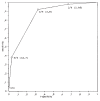Clinical predictors of positive urine cultures in young children at risk for urinary tract infection
- PMID: 20020011
- PMCID: PMC2792661
- DOI: 10.1093/pch/8.3.145
Clinical predictors of positive urine cultures in young children at risk for urinary tract infection
Abstract
Background: Urinary tract infections (UTIs) are a common source of bacterial infection among young febrile children. The diagnosis of UTI is challenging because the clinical presentation is not specific.
Objective: To describe clinical predictors to identify young children needing urine culture for evaluation of UTI.
Methods: Retrospective cohort study of all children younger than two years of age (719 hospital visits for 545 patients) suspected of having a UTI during a 12-month period. The outcome was UTI, defined as a catheterized urine culture with pure growth of 10⁴ colonies/mL or greater, or suprapubic aspiration culture with 10³ colonies/mL or greater. Candidate predictors included demographic, historical and physical examination variables.
Results: The medical records of 545 children younger than two years of age were reviewed. Forty-six per cent were girls. Mean age was 9.1 months (SD 7 months). Four variables were found to predict UTI: absence of another source of fever on examination (odds ratio [OR]=41.6 [95% CI, 8.8 to 197.4]), foul smelling urine (OR=19.7 [95% CI, 5.7 to 68.2]), white blood cell count greater than 15,000/mm³ (OR=4.3 [95% CI, 2.0 to 9.3]), younger than six months old (OR=3.1 [95% CI, 1.3 to 7.1]). The sensitivity of an abnormal urine analysis was 0.77 (95% CI, 0.66 to 0.88) and the specificity was 0.31 (95% CI, 0.2 to 0.42).
Conclusion: An incremental increase in risk for UTI is associated with younger age (younger than six months), having a white blood cell count higher than 15,000/mm³, parental report of malodorous or foul smelling urine and the absence of an alternative source of fever. In the present patient population, obtaining a urine culture from children with at least one of these clinical predictors would have resulted in missing one UTI (2%), and 111 negative cultures (20%) would have been avoided.
HISTORIQUE :: Les infections urinaires (IU) sont une source courante d’infection bactérienne chez les jeunes enfants fiévreux. Le diagnostic d’IU est souvent difficile à cerner parce qu’à l’accoutumée, la présentation clinique n’est pas spécifique.
OBJECTIF :: Décrire les prédicteurs cliniques afin de repérer les jeunes enfants devant subir une uroculture pour évaluer une IU.
MÉTHODOLOGIE :: Étude rétrospective des cohortes de tous les enfants de moins de deux ans (719 consultations à l’hôpital par 545 patients) présumés avoir une IU sur une période de 12 mois. L’issue était une IU, définie comme une uroculture par cathéter avec croissance pure d’au moins 104 colonies/mL, ou comme une culture par ponction suspubienne d’au moins 103 colonies/mL. Les prédicteurs candidats incluaient des variables démographiques, historiques et physiques.
RÉSULTATS :: Ont été examinés les dossiers médicaux de 545 enfants de moins de deux ans. Quarante-six pour cent étaient des fillettes. L’âge moyen était de 9,1 mois (ÉT = 7 mois). On a découvert quatre variables prédictives d’une IU : l’absence d’une autre source de fièvre à l’examen (risque relatif [RR] = 41,6 [95 % IC, 8,8 à 197,4]), urine fétide (RR = 19,7 [95 % IC, 5,7 à 68,2]), numération leucocytaire supérieure à 15 000/mm3 (RR = 4,3 [95 % IC, 2,0 à 9,3]), âge inférieur à six mois (RR = 3,1 [95 % IC, 1,3 à 7,1]). La sensibilité d’une analyse d’urine anormale était de 0,77 (95 % IC, 0,66 à 0,88), et sa spécificité, de 0,31 (95 % IC, 0,2 à 0,42).
CONCLUSION :: Une augmentation incrémentielle du risque d’IU est associée à un très jeune âge (moins de six mois), à une numération leucocytaire supérieure à 15 000/mm3, à la présence d’une urine malodorante ou fétide déclarée par le parent et à l’absence d’autre source de fièvre. Au sein de la population actuelle de patients, une IU (2 %) aurait été ratée malgré l’obtention d’une uroculture auprès d’enfants présentant au moins l’un de ces prédicteurs cliniques, et 111 cultures négatives (20 %) auraient été évitées.
Keywords: Children; Diagnosis; Urinary tract infection.
Figures
References
-
- Shaw KN, Gorelick MH. Urinary tract infection in the pediatric patient. Pediatr Clin North Am. 1999;46:1111–24. - PubMed
-
- Marild S, Jodal U. Incidence rate of first-time symptomatic urinary tract infection in children under 6 years of age. Acta Paediatr. 1998;87:549–52. - PubMed
-
- American Academy of Pediatrics, Committee on Quality Improvement, Subcommittee on Urinary Tract Infection The Diagnosis, Treatment, and Evaluation of the Initial Urinary Tract Infection in Febrile Infants and Young Children (SV9830) Pediatrics. 1999;103:843–52. - PubMed
-
- Hoberman A, Chao HP, Keller DM, et al. Prevalence of urinary tract infection in febrile infants. J Pediatr. 1993;123:17–23. - PubMed
LinkOut - more resources
Full Text Sources

